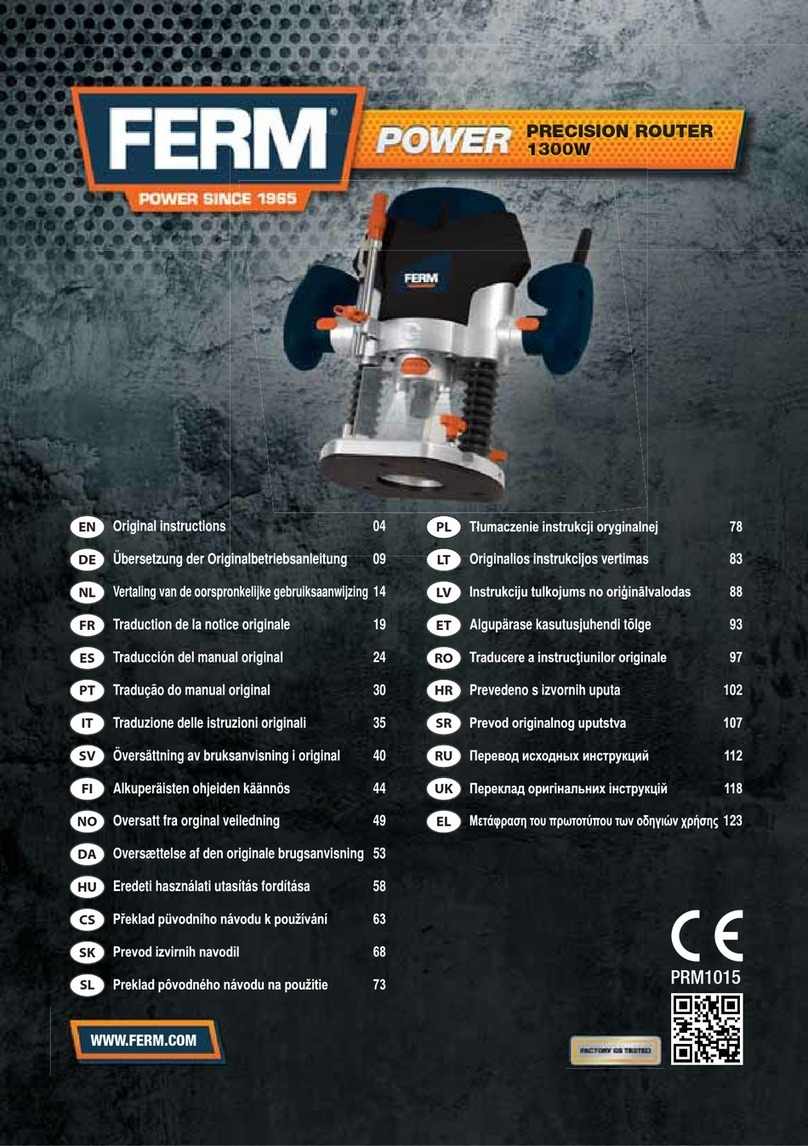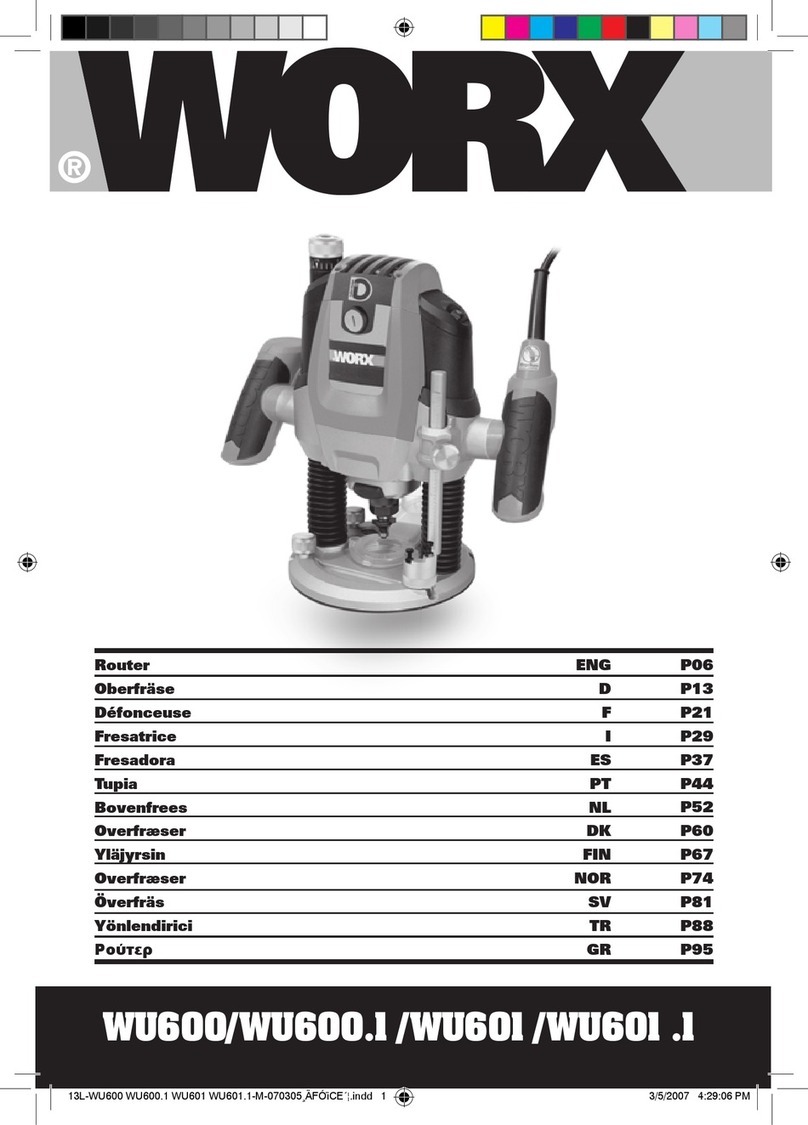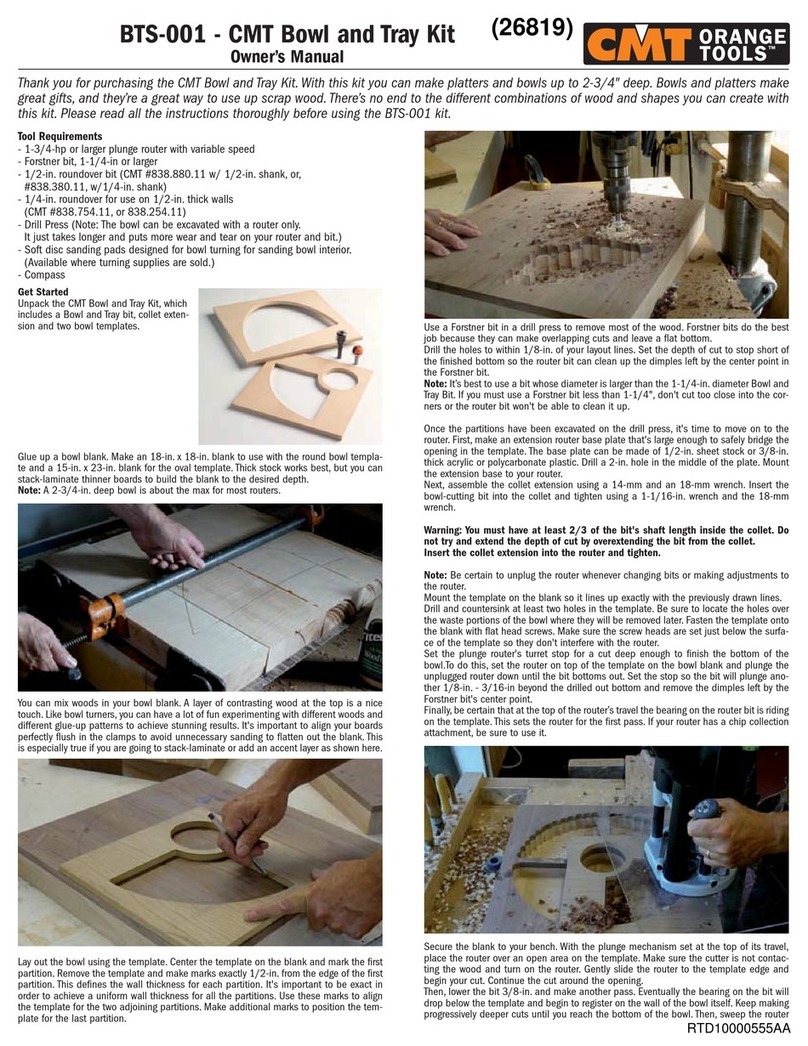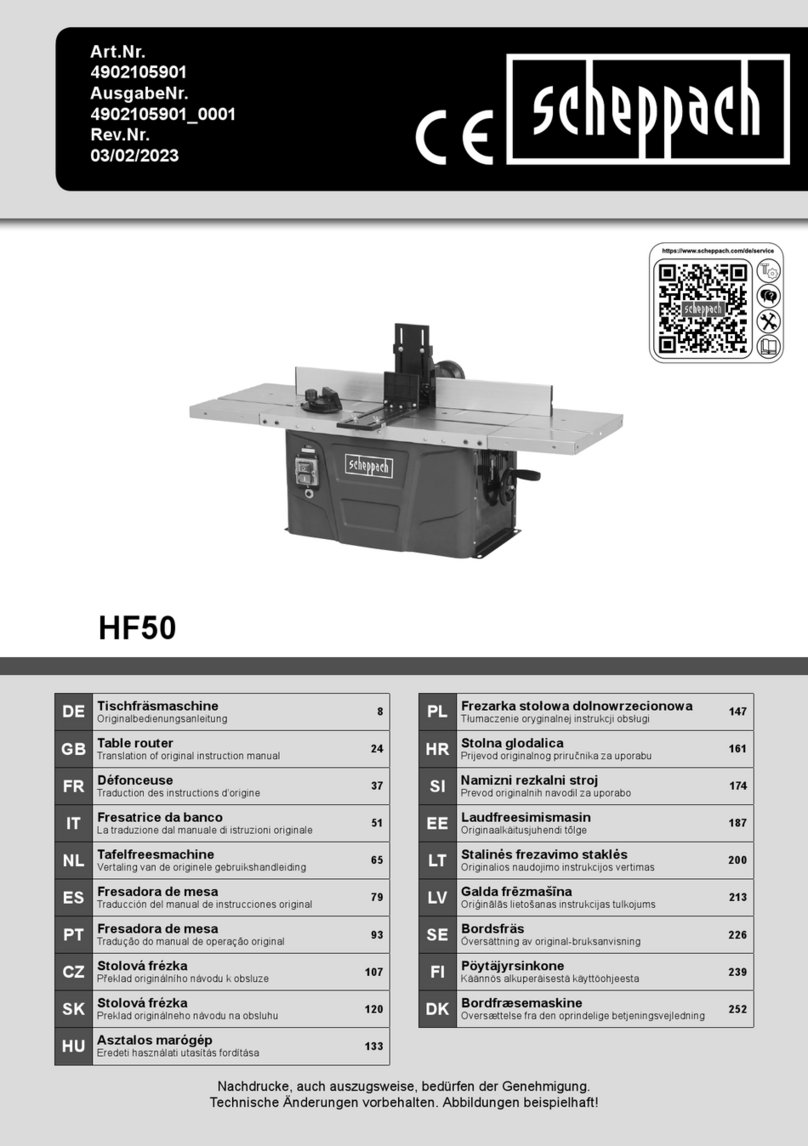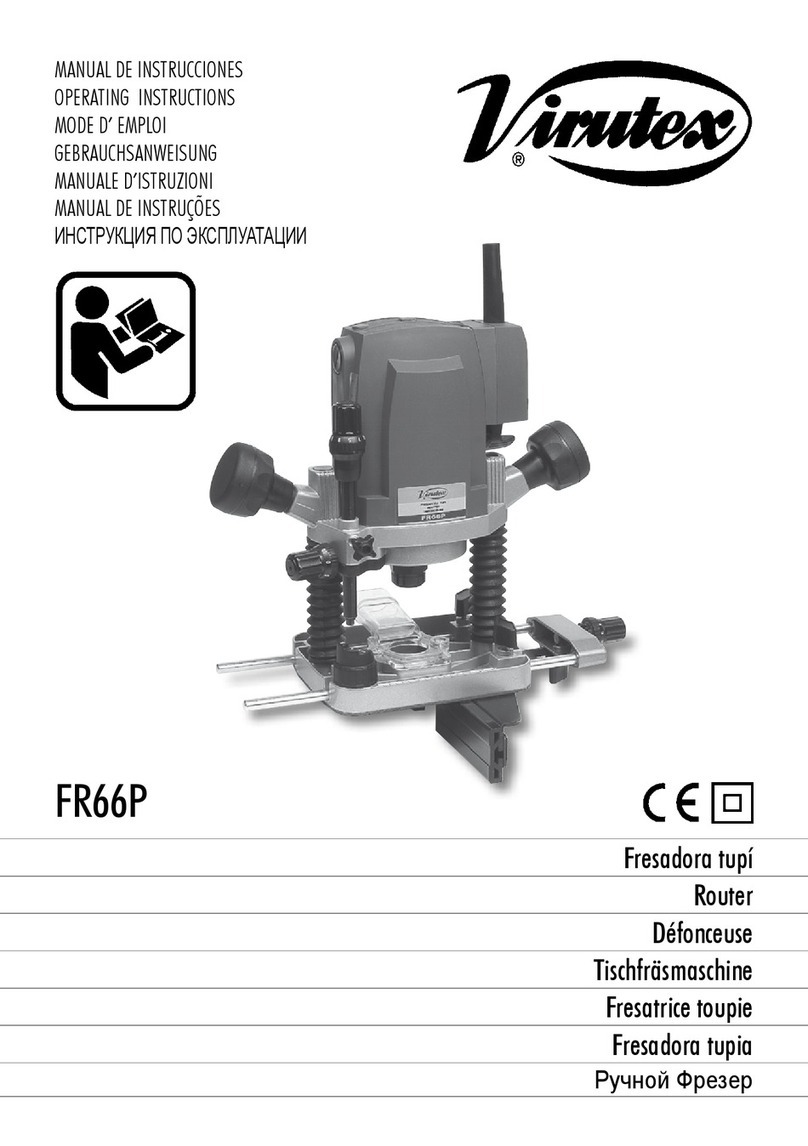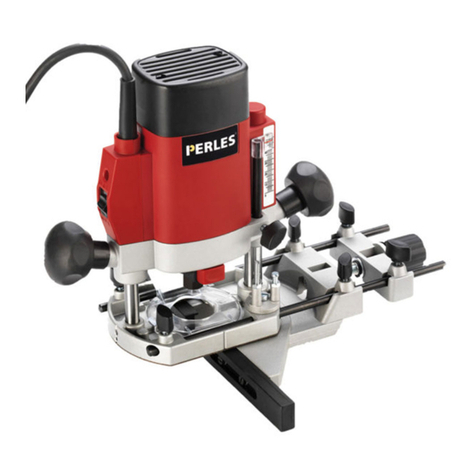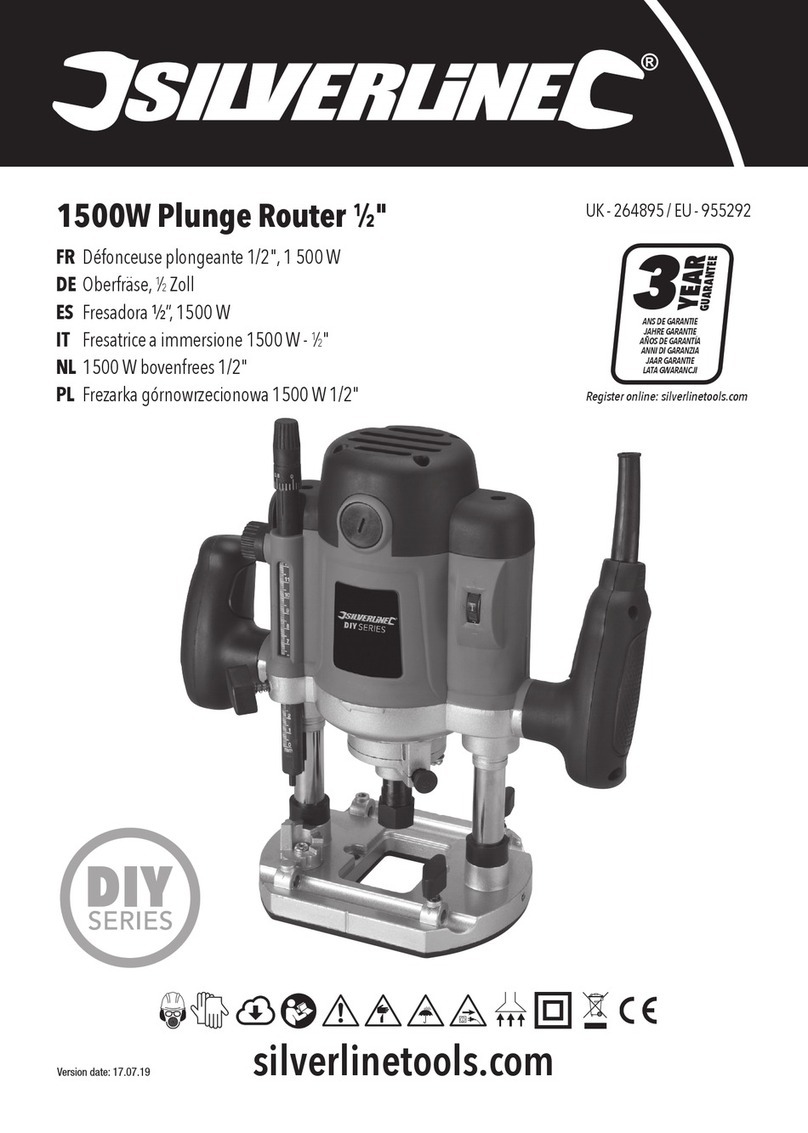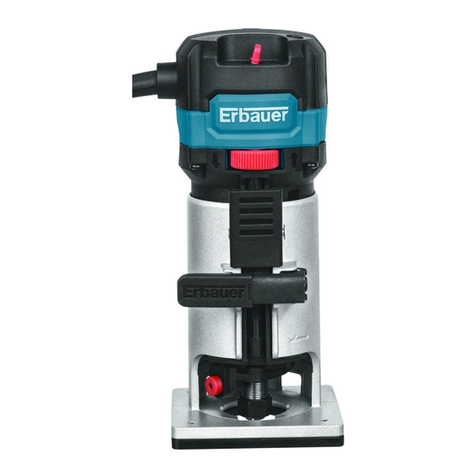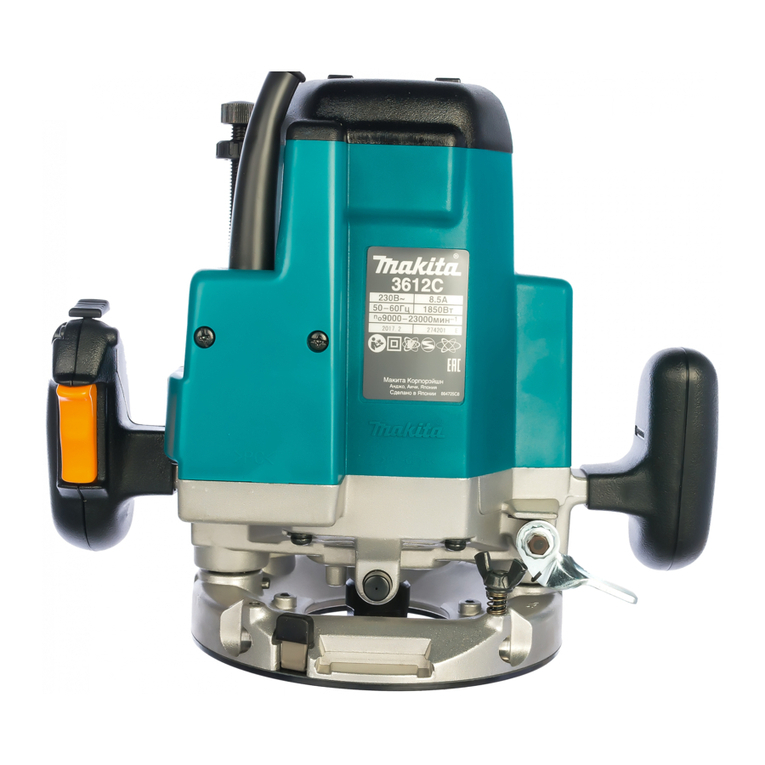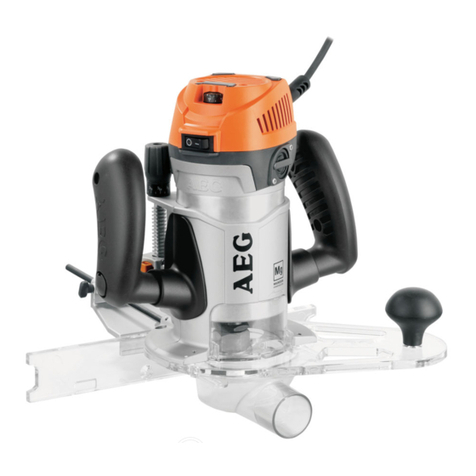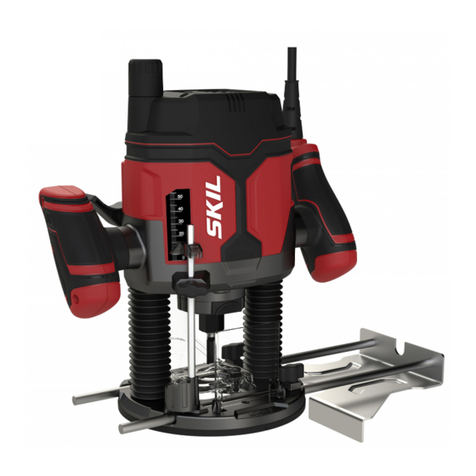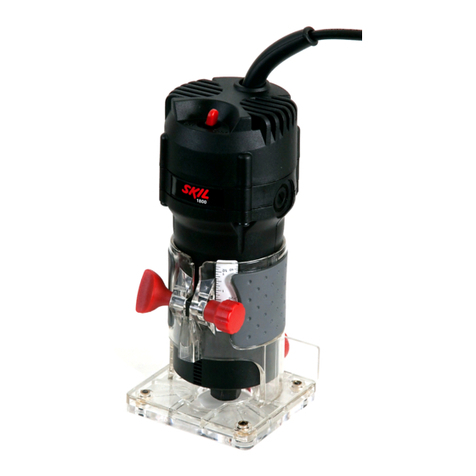Ingco RT22008 User manual

EN
Router
Router
RT22008 URT22008 RT22008-4 RT22008-8 RT22008-9
ingcoglobal
INGCO GLOBAL

2|English
The symbols in instruction manual and the label on the tool
Double insulated for additional protection.
Read the instruction manual before using.
CE conformity.
Wear safety glasses, hearing protection and dust mask.
Waste electrical products should not be disposed of with household waste.
Please recycle where facilities exist. Check with your Local Authority or
retailer for recycling advice.
Safety alert.
Please only use the accessories supported by the manufacture.

3|English
follow the warnings and instructions may result in electric shock, fire and/or
serious injury.
Save all warnings and instructions for future reference.
The term "power tool" in the warnings refers to your mains-operated (corded)
power tool or battery-operated (cordless) power tool.
1)
Work area safety
a)
Keep work area clean and well lit.
Cluttered and dark areas invite
accidents.
b)
Do not operate power tools in explosive atmospheres, such as
in the presence of flammable liquids, gases or dust.
Power tools
create sparks which may ignite the dust orfumes.
c)
Keep children and bystanders away while operating a power
tool.
Distractions can cause you to losecontrol.
2)
Electrical safety
a)
Power tool plugs must match the outlet. Never modify the plug
in any way. Do not use any adapter plugs with earthed
(grounded) power tools.
Unmodified plugs and matching outlets will
reduce risk of electric shock.
b)
Avoid body contact with earthed or grounded surfaces such as
pipes, radiators, ranges and refrigerators.
There is an increased
risk of electric shock if your body is earthed or grounded.
c)
Do not expose power tools to rain or wet conditions.
Water
entering a power tool will increase the risk of electric shock.
d)
Do not abuse the cord. Never use the cord for carrying, pulling
or unplugging the power tool. Keep cord away from heat, oil,
sharp edges or moving parts.
Damaged or entangled cords
increase the risk of electric shock.
e)
When operating a power tool outdoors, use an extension cord
suitable for outdoor use.
Use of a cord suitable for outdoor use
reduces the risk of electric shock.
f)
If operating a power tools in a damp location is unavoidable, use
WARNING Read all safety warnings and all instructions
. Failure to
GENERAL POWER TOOL SAFETY WARNINGS

4|English
a residual current device (RCD) protected supply.
Use of an RCD
reduces the risk of electric shock.
3)
Personal safety
a)
Stay alert, watch what you are doing and use common sense
when operating a power tool. Do not use a power tool while you
are tired or under the influence of drugs, alcohol or medication.
A moment of inattention while operating power tools may result in
serious personal injury.
b)
Use personal protective equipment. Always wear eye protection.
Protective equipment such as dust mask, non-skid safety shoes,
hard hat, or hearing protection used for appropriate conditions will
reduce personal injuries.
c)
Prevent unintentional starting. Ensure the switch is in the off-
position before connecting to power source and/or battery pack,
picking up or carrying the tool.
Carrying power tools with your
finger on the switch or energizing power tools that have the switch on
invites accidents.
d)
Remove any adjusting key or wrench before turning the power
tool on.
A wrench or a key left attached to a rotating part of the
power tool may result in personal injury.
e)
Do not overreach. Keep proper footing and balance at all times.
This enables better control of the power tool in unexpected
situations.
f)
Dress properly. Do not wear loose clothing or jewellery. Keep
your hair, clothing and gloves away from moving parts.
Loose
clothes, jewellery or long hair can be caught in moving parts.
g)
If devices are provided for the connection of dust extraction and
collection facilities, ensure these are connected and properly
used.
Use of dust collection can reduce dust-related hazards.
4)
Power tool use and care
a)
Do not force the power tool. Use the correct power tool for your
application.
The correct power tool will do the job better and safer at
the rate for which it was designed.
b)
Do not use the power tool if the switch does not turn it on and off.
Any power tool that cannot be controlled with the switch is dangerous

5|English
and must be repaired.
c)
Disconnect the plug from the power source and/or the battery
pack from the power tool before making any adjustments,
changing accessories, or storing power tools. Such preventive
safety measures reduce the risk of starting the power tool accidentally.
d)
Store idle power tools out of the reach of children and do not allow
persons unfamiliar with the power tool or these instructions to
operate the power tool. Power tools are dangerous in the hands of
untrained users.
e)
Maintain power tools. Check for misalignment or binding of
moving parts, breakage of parts and any other condition that may
affect the power tools operation. If damaged, have the power tool
repaired before use. Many accidents are caused by poorly maintained
power tools.
f)
Keep cutting tools sharp and clean. Properly maintained cutting tools
with sharp cutting edges are less likely to bind and are easier to control.
g)
Use the power tool, accessories and tool bits etc. in accordance
with these instructions, taking into account the working
conditions and the work to be performed. Use of the power tool for
operations different from those intended could result in a hazardous
situation.
5) Service
a)
Have your power tool serviced by a qualified repair person using
only identical. This will ensure that the safety of the power tool is
maintained.
Additional SafetyWarnings
-Hold power tool by insulated gripping surfaces, because the cutter may contact its own
cord. Cutting a "live" wire may make exposed metal parts of the power tool "live" and shock the
operator.
-Use clamps or another practical way to secure and support the workpiece to a stable
platform. Holding the work by your hand or against the body leaves it unstable and may lead to
loss of control.
-Use clamps or another practical way to secure and support the workpiece to a stable
platform. Holding the work by your hand or against the body leaves it unstable and may lead to
loss of control.

6|English
SPECIFICATIONS
Model No.:
RT22008
RT22008-4
RT22008-
8
RT22008-9
URT22008
Rated input power:
2200W
2200W
Rated voltage:
220-240V~50/60Hz
110-120V~50/60Hz
No-load speed:
14000-20000/min
14000-20000/min
Diameter of collet :
6mm, 8mm, 12mm, 1/4
˝
, 1/2
˝
1/4
˝,
1/2
˝
Plunge capacity:
0-60mm
0~
2-3/8˝
Manufacturer reserves the right to change specifications without notice.
Specifications may differ from country to country.
GENERAL SAFETY RULES
(For All Tools)
WARNING:
Read and understand all instructions. Failure to follow all
instructions listed below, may result in electric shock, fire and/or
serious personal injury.
SAVE THESE INSTRUCTIONS
Work Area
1.
Keep your work area clean and well lit.
Cluttered benches and dark areas invite acci-
dents.
2.
Do not operate power tools in explosive
atmospheres, such as in the presence of
flammable liquids, gases, or dust. Power
tools create sparks which may ignite the dust
or fumes.
3.
Keep bystanders, children, and visitors
away while operating a power tool. Distrac-
tions can cause you to lose control.
Electrical Safety
4.
Double insulated tools are equipped with
a polarized plug (one blade is wider than
the other.) This plug will fit in a polarized
outlet only one way. If the plug does not fit
fully in the outlet, reverse the plug. If it
still does not fit, contact a qualified elec-
trician to install a polarized outlet. Do not
change the plug in any way. Double insula-
tion eliminates the need for the three wire
grounded power cord and grounded power
supply system.

7|English
5.
Avoid body contact with grounded sur-
faces such as pipes, radiators, ranges and
refrigerators. There is an increased risk of
electric shock if your body is grounded.
6.
Do not expose power tools to rain or wet
conditions. Water entering a power tool will
increase the risk of electric shock.
7.
Do not abuse the cord. Never use the cord
to carry the tools or pull the plug from an
outlet. Keep cord away from heat, oil,
sharp edges or moving parts. Replace
damaged cords immediately. Damaged
cords increase the risk of electric shock.
8.
When operating a power tool outside, use
an outdoor extension cord marked “W-A”
or “W”. These cords are rated for outdoor
use and reduce the risk of electric shock.
Personal Safety
9.
Stay alert, watch what you are doing and
use common sense when operating a
power tool. Do not use tool while tired or
under the influence of drugs, alcohol, or
medication. A moment of inattention while
operating power tools may result in serious
personal injury.
10.
Dress properly. Do not wear loose cloth-
ing or jewelry. Contain long hair. Keep
your hair, clothing, and gloves away from
moving parts. Loose clothes, jewelry, or long
hair can be caught in moving parts.
11.
Avoid accidental starting. Be sure switch
is off before plugging in. Carrying tools with
your finger on the switch or plugging in tools
that have the switch on invites accidents.
12.
Remove adjusting keys or wrenches
before turning the tool on. A wrench or a
key that is left attached to a rotating part of
the tool may result in personal injury.
13.
Do not overreach. Keep proper footing
and balance at all times. Proper footing and
balance enables better control of the tool in
unexpected situations.
14.
Use safety equipment. Always wear eye
protection. Dust mask, non-skid safety
shoes, hard hat, or hearing protection must
be used for appropriate conditions. Ordinary
eye or sun glasses are NOT eye protection.
Tool Use and Care
15.
Use clamps or other practical way to
secure and support the workpiece to a
stable platform. Holding the work by hand or
against your body is unstable and may lead
to loss of control.
16.
Do not force tool. Use the correct tool for
your application. The correct tool will do the
job better and safer at the rate for which it is
designed.
17.
Do not use tool if switch does not turn it
on or off. Any tool that cannot be controlled
with the switch is dangerous and must be
repaired.
18.
Disconnect the plug from the power
source before making any adjustments,
changing accessories, or storing the tool.
Such preventive safety measures reduce the
risk of starting the tool accidentally.
19.
Store idle tools out of reach of children
and other untrained persons. Tools are
dangerous in the hands of untrained users.
20.
Maintain tools with care. Keep cutting
tools sharp and clean. Properly maintained
tools with sharp cutting edges are less likely
to bind and are easier to control.
21.
Check for misalignment or binding of
moving parts, breakage of parts, and any
other condition that may affect the tools
operation. If damaged, have the tool ser-
viced before using. Many accidents are
caused by poorly maintained tools.
22.
Use only accessories that are recom-
mended by the manufacturer for your
model. Accessories that may be suitable for
one tool, may become hazardous when used
on another tool.

8|English
SERVICE
23.
Tool service must be performed only by
qualified repair personnel. Service or main-
tenance performed by unqualified personnel
could result in a risk of injury.
24.
When servicing a tool, use only identical
replacement parts. Follow instructions in
the Maintenance section of this manual.
Use of unauthorized parts or failure to follow
Maintenance instructions may create a risk of
electric shock or injury.
SPECIFIC SAFETY RULES
DO NOT let comfort or familiarity with product (gained from
repeated use) replace strict adherence to router safety rules. If
you use this tool unsafely or incorrectly, you can suffer serious
personal injury.
1.
Hold tool by insulated gripping surfaces
when performing an operation where the
cutting tool may contact hidden wiring or
its own cord. Contact with a “live” wire will
make exposed metal parts of the tool “live”
and shock the operator.
2.
Wear hearing protection during extended
period of operation.
3.
Handle the bits very carefully.
4.
Check the bit carefully for cracks or dam-
age before operation. Replace cracked or
damaged bit immediately.
5.
Avoid cutting nails. Inspect for and
remove all nails from the workpiece
before operation.
6.
Hold the tool firmly with both hands.
7.
Keep hands away from rotating parts.
8.
Make sure the bit is not contacting the
workpiece before the switch is turned on.
9.
Before using the tool on an actual work-
piece, let it run for a while. Watch for
vibration or wobbling that could indicate
improperly installed bit.
10.
Be careful of the bit rotating direction and
the feed direction.
11.
Do not leave the tool running. Operate the
tool only when hand-held.
12.
Always switch off and wait for the bit to
come to a complete stop before removing
the tool from workpiece.
13.
Do not touch the bit immediately after
operation; it may be extremely hot and
could burn your skin.
14.
Always lead the power supply cord away
from the tool towards the rear.
15.
Do not smear the tool base carelessly with
thinner, gasoline, oil or the like. They may
cause cracks in the tool base.
16.
Draw attention to the need to use cutters
of the correct shank diameter and suitable
for the speed of the tool.
17.
Some material contains chemicals which
may be toxic. Take caution to prevent dust
inhalation and skin contact. Follow mate-
rial supplier safety data.
SAVE THESE INSTRUCTIONS
WARNING:
MISUSE or failure to follow the safety rules stated in this
instruction manual may cause serious personal injury.

9|English
FUNCTIONAL
DESCRIPTION
1. Stopper pole
2. Fast-feed button
3. Adjusting hex bolt
4. Stopper block
1. Knob
CAUTION:
•
Always be sure that the tool is switched off and
unplugged before adjusting or checking function on the
tool.
Adjusting the depth of cut
Place the tool on a flat surface. Loosen the lock lever and
lower the tool body until the bit just touches the flat surface.
Press the lock lever down to lock the tool body.
Now lower the stopper pole until it makes contact with the
adjusting hex bolt. The stopper pole can be moved rapidly by
depressing the fast-food button. While pressing the fast-feed
button, raise the stopper pole until the desired depth of cut is
obtained. The depth of cut is equal to the distance between
the stopper pole and the adjusting hex bolt. Stopper pole
travel can be checked with the scale (1 mm or 1/16” per grad-
uation) on the tool body. Minute depth adjustments can be
obtained by turning the stopper pole (1.5 mm or about 1/16”
per turn).
Now, your predetermined depth of cut can be obtained by
loosening the lock lever and then lowering the tool body until
the stopper pole makes contact with the adjusting hex bolt.
By turning the knob, the upper limit of the tool body can be
adjusted. When the tip of the bit is retracted more than
required in relation to the base plate surface, turn the knob to
lower the upper limit.
CAUTION:
•
Since excessive cutting may cause overload of the motor
or difficulty in controlling the tool, the depth of cut should
not be more than 20 mm (13/16”) at a pass when cutting
grooves. When you wish to cut grooves more than 20
mm (13/16”) deep, make several passes with
progressively deeper bit settings.
•
Do not lower the knob too low. The bit will protrude
dangerously.
1
2
3
4
1

10|English
1. Stopper pole
2. Hex bolt
3. Hex nut
4. Stopper block
1. Switch lever
Stopper block
The stopper block has three adjusting hex bolts which raise
or lower 0.8 mm (1/32”) per turn. You can easily obtain three
different depths of cut using these adjusting hex bolts without
readjusting the stopper pole.
Adjust the lowest hex bolt to obtain the deepest depth of cut,
following the method of “Adjusting depth of cut”. Adjust the
two remaining hex bolts to obtain shallower depths of cut.
The differences in height of these hex bolts are equal to the
differences in depths of cut.
To adjust the hex bolts, first loosen the hex nuts on the hex
bolts with the wrench and then turn the hex bolts. After
obtaining the desired position, tighten the hex nuts while
holding the hex bolts in that desired position. The stopper
block is also convenient for making three passes with pro-
gressively deeper bit settings when cutting deep grooves.
Switch action
CAUTION:
•
Before plugging in the tool, always check to see that the
tool is switched off.
•
Switch can be locked in “ON” position for ease of
operator comfort during extended use. Apply caution
when locking tool in “ON” position and maintain firm
grasp on tool.
•
Make sure that the shaft lock is released before the
switch is turned on.
•
Hold the tool firmly when turning off the tool, to
overcome the reaction.
To start the tool, move the switch lever to the ON position.
To stop the tool, move the switch lever to the OFF position.
1
4
2
3
1

11|English
1. Speed adjusting dial
Speed adjusting dial
The tool speed can be changed by turning the speed adjust-
ing dial to a given number setting from 1 to 6.
Higher speed is obtained when the dial is turned in the direc-
tion of number 6. And lower speed is obtained when it is
turned in the direction of number 1.
This allows the ideal speed to be selected for optimum mate-
rial processing, i.e. the speed can be correctly adjusted to
suit the material and bit diameter.
Refer to the table for the relationship between the number
settings on the dial and the approximate tool speed.
CAUTION:
If the tool is operated continuously at low speeds for a
long time, the motor will get overloaded, resulting in tool
malfunction.
The speed adjusting dial can be turned only as far as 6
and back to 1. Do not force it past 6 or 1, or the speed
adjusting function may no longer work.
ASSEMBLY CAUTION:
Always be sure that the tool is switched off and
unplugged before carrying out any work on the tool.
1. Wrench
2. Shaft lock
3. Lock lever
Installing or removing the bit
CAUTION:
Install the bit securely. Always use only the wrench
provided with the tool. A loose or overtightened bit can
be dangerous.
Do not tighten the collet nut without inserting a bit or
install small shank bits without using a collet sleeve.
Either can lead to breakage of the collet cone.
Insert the bit all the way into the collet cone. Press the shaft
lock to keep the shaft stationary and use the wrench to
tighten the collet nut securely. When using router bits with
smaller shank diameter, first insert the appropriate collet
sleeve into the collet cone, then install the bit as described
above.
To remove the bit, follow the installation procedure in reverse.
1
1
2
3
Number
RPM
1
9,000
2
12,000
3
16,000
4
19,000
5
21,000
6
23,000

12|English
OPERATION
1. Chip deflector
CAUTION:
•
Before operation, always make sure that the tool body
automatically rises to the upper limit and the bit does not
protrude from the tool base when the lock lever is
loosened.
•
Before operation, always make sure that the chip
deflector is installed properly.
Set the tool base on the workpiece to be cut without the bit
making any contact. Then turn the tool on and wait until the
bit attains full speed. Lower the tool body and move the tool
forward over the workpiece surface, keeping the tool base
flush and advancing smoothly until the cutting is complete.
When doing edge cutting, the workpiece surface should be
on the left side of the bit in the feed direction.
1. Workpiece 2. Bit revolvingdirection
3. View from the top of the tool 4. Feeddirection
1. Feed direction
2. Bit revolving direction
3. Workpiece
4. Straight guide
NOTE:
•
Moving the tool forward too fast may cause a poor
quality of cut, or damage to the bit or motor. Moving the
tool forward too slowly may burn and mar the cut. The
proper feed rate will depend on the bit size, the kind of
workpiece and depth of cut. Before beginning the cut on
the actual workpiece, it is advisable to make a sample
cut on a piece of scrap lumber. This will show exactly
how the cut will look as well as enable you to check
dimensions.
•
When using the straight guide or the trimmer guide, be
sure to install it on the right side in the feed direction.
This will help to keep it flush with the side of the
workpiece.
3
2
4
4
1
2
1
4
1
3
2

13|English
1. Wing bolt (A)
2. Guide holder
3. Fine adjusting screw
4. Wing bolt (B)
5. Straight guide
1. More than 15mm (5/8”)
2. Straight guide
3. Wood
Straight guide
The straight guide is effectively used for straight cuts when
chamfering or grooving.
Install the straight guide on the guide holder with the wing
bolt (B). Insert the guide holder into the holes in the tool base
and tighten the wing bolt (A). To adjust the distance between
the bit and the straight guide, loosen the wing bolt (B) and
turn the fine adjusting screw (1.5 mm or about 1/16” per
turn). At the desired distance, tighten the wing bolt (B) to
secure the straight guide in place.
Wider straight guide of desired dimensions may be made by
using the convenient holes in the guide to bolt on extra
pieces of wood.
When using a large diameter bit, attach pieces of wood to
the straight guide which have a thickness of more than
15 mm (5/8”) to prevent the bit from striking the straight
guide.
When cutting, move the tool with the straight guide flush with
the side of the workpiece.
Templet guide
The templet guide provides a sleeve through which the bit
passes, allowing use of the tool with templet patterns.
1
2
3
4
5
1
2
55 mm
( 2 - 3/16" )
3 55 mm
( 2 - 3/16" )

14|English
To install the templet guide, loosen the screws on the tool
base, insert the templet guide and then tighten the screws.
1. Templet guide
2. Screw
3. Base plate
1. Bit
2. Base
3. Templet
4. Workpiece
5. Distance (X)
6. Outside diameter of the templet
guide
7. Templet guide
Secure the templet to the workpiece. Place the tool on the
templet and move the tool with the templet guide sliding
along the side of the templet.
NOTE:
•
The workpiece will be cut a slightly different size from the
templet. Allow for the distance (X) between the bit and
the outside of the templet guide. The distance (X) can be
calculated by using the following equation:
Distance (X) = (outside diameter of the templet guide –
bit diameter) / 2
Trimmer guide
Trimming, curved cuts in veneers for furniture and the like
can be done easily with the trimmer guide. The guide roller
rides the curve and assures a fine cut.
1
7
2
3
4
5
6
2
1
3

15|English
1. Wing bolt (A)
2. Guide holder
3. Fine adjusting screw
4. Wing bolt (B)
5. Wing bolt (C)
6. Trimmer guide
7. Guide roller
Install the trimmer guide on the guide holder with the wing
bolt (B). Insert the guide holder into the holes in the tool base
and tighten the wing bolt (A). To adjust the distance between
the bit and the trimmer guide, loosen the wing bolt (B) and
turn the fine adjusting screw (1.5 mm or 1/16” per turn).
When adjusting the guide roller up or down, loosen the wing
bolt (C). After adjusting, tighten all the wing bolts securely.
When cutting, move the tool with the guide roller riding the
side of the workpiece.
1. Bit
2. Guide roller
1
2
3
4
5
6
7
1
2

16|English
MAINTENANCE CAUTION:
Always be sure that the tool is switched off and
unplugged before attempting to perform inspection or
maintenance.
Replacing carbon brushes
Remove and check the carbon brushes regularly.
Keep the carbon brushes clean and free to slip in the holders.
Both carbon brushes should be replaced at the same
time.Use only identical carbon brushes.
1. Brush holder cap
2. Knob
3. Screwdriver
Use a screwdriver to remove the brush holder caps. Take out
the worn carbon brushes, insert the new ones and secure
the brush holder caps.
NOTE:
When replacing carbon brush located on the same side
as the knob, remove the knob first before unscrewing the
brush holder cap.
CAUTION:
Be sure to re-install the knob after inserting new carbon
brush.
After replacing brushes, plug in the tool and break in brushes
by running tool with no load for about 10 minutes. Then
check the tool while running and electric brake operation
when releasing the switch trigger.
To maintain product SAFETY and RELIABILITY, repairs, any
other maintenance or adjustment should be performed by
INGCO Authorized Centers,always using INGCO replacement
parts.
1
2
3

17|English
ACCESSORIES CAUTION:
These accessories or attachments are recommended for
use with your INGCO tool specified in this manual. The
use of any other accessories or attachments might
present a risk of injury to persons. Only use accessory
or attachment for its stated purpose.
If you need any assistance for more details regarding these
accessories, ask your local INGCO service center.
Straight guide
Trimmer guide
Guide holder
Templet guides
Lock nut
Collet sleeve 6,8,12mm,1/4˝,1/2˝
(for RT22008, RT22008-4,RT22008-9)
Collet sleeve 1/4˝,1/2˝(for URT22008)
Wrenches

18|English
RT22008,URT22008,RT22008-4,RT22008-8,RT22008-9

19|English
SPARE PART LIST
RT22008,URT22008,RT22008-4,RT22008-8,RT22008-9
No.
Part Description
Qty
No.
Part Description
Qty
1
Screw
2
41
Switch
1
2
Back cover
1
42
Screw
3
3
Controller
1
43
Screw
2
4
Housing
1
44
Switch cover
1
5
spring
2
45
Cable
1
6
Stator
1
46
Cable protection sleeve
1
7
Wind ring
1
47
Adjust nut
1
8
bearing
1
48
Adjust lever
1
9
Dust ring
1
49
Guide rod
2
10
Rotor
1
50
Bolt
2
11
Screw
2
51
Support Seat
1
12
Bearing plate
1
52
Butterfly screw
1
13
Bearing
1
53
Position bolt
1
14
Right handle cover
1
54
Support rod
1
15
Right handle
1
55
Spring
2
16
Gear housing
1
56
Pipe
2
17
Steel bushing
2
57
Screw
2
18
Screw
4
58
Bolt
1
19
Nut
1
59
Screw
3
20
Nut spring
1
60
Spring
4
21
Chuck nut assembly
1
61
Bolt
1
22
Left handle cover
1
62
Spring
1
23
Left handle
1
63
Screw
1
24
Screw
2
64
Screw
1
25
Torsion spring
1
65
Screw
1
26
Bolt
1
66
Bolt
3
27
Lock handle
1
67
Depth adjust block
1
28
Bolt
1
68
Bolt
2
29
Locking cap
1
69
Base
1
30
Retainer ring
1
70
Base plate
1
31
Locking cap
1
71
Screw
4
32
Spring
1
72
Protection cover
1
33
Steel sleeve B
2
73
Screw
1
34
Depth adjust Bolt
1
74
Big Wrench
1
35
Screw
2
75
Bracket
1
36
Brush box
2
76
Small Wrench
1
37
Carbon brush
2
77
Roller assembly
1
38
Brush holder
2
78
Guide plate
1
39
Cable plate
1
79
Collet chuck
1
40
Screw
2
80
Collet chuck
1
This manual suits for next models
4
Table of contents


